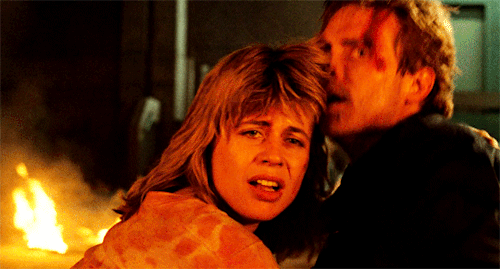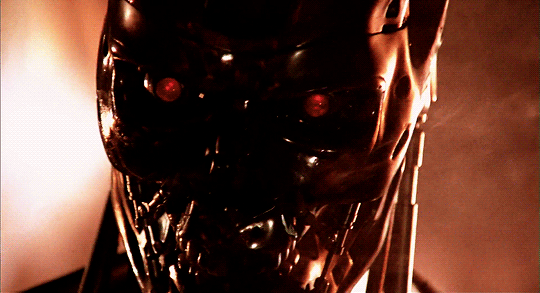By Christian Eltell
Written on April 10, 2018; Published on December 2, 2019
Critic Rating: 4/4 Stars
35th Anniversary Analysis and Review

Steven Spielberg gave the world entertaining blockbusters such as Jaws and Indiana Jones, as did George Lucas with Star Wars. James Cameron took his turn in 1984 when The Terminator became the director’s first major hit at the box office. Not only did this sci-fi epic launch Cameron’s directing career, but bodybuilder turned actor Arnold Schwarzenegger became a mega superstar. The Terminator is an 80s blockbuster that’s similar to other action films during this decade, including Die Hard and Robocop, in terms of masculine protagonists, graphic violence, and vulgar language. Cameron’s film also relates to other sci-fi epics of the 80s and 90s, including The Matrix and Blade Runner franchises, in which humans and machines are at war with each other, and the fate of humanity is in crisis. Although The Terminator is a much darker film than Back to the Future, there are instances of time travel, and looking into the future. In Cameron’s film, the male war hero named Kyle Reese, and the cyborg villain named the T-800, each travel back in time in the city of Los Angeles, from the futuristic, apocalyptic war of 2029, to the present year 1984. The soldier is sent back to save Sarah Connor, “the mother of the future,” while the cyborg’s mission is to kill her and anyone who stands in its way. The Terminator is also similar to conspiracy thrillers of the 1970s due to the paranoia surrounding the nature of the cyborg, who’s disguised as a man, and Reese’s identity. Initially, Sarah doesn’t believe Reese, and considers him crazy when he tells her a machine is going to kill her because her unborn son will be the one to save humanity from the machines. The L.A. police and the police psychologist also find Reese’s story unbelievable and outlandish.



Arnold Schwarzenegger portrays the cyborg, T-800, as a large, muscle-bound, masculine figure. On the inside, the machine is a metal skeleton made up of stainless steel. On the outside, the cyborg is disguised as a man, but the skin tissue is fake, even though it looks very real. Not only does this film contain elements of action and science fiction, but it’s also played out like a horror movie, but one with more intelligence. Unlike mindless villains from slasher films, including Freddy Kruger, Michael Myers, or Jason Voorhees, Schwarzenegger’s “Terminator” is filled with knowledge about everything, from the use of guns and weaponry, to encountering personal information about other people, including their identification, clothing size, family, friends, relatives, telephone contacts, appearance, where they live, etc. Despite minimal dialogue, the cyborg’s mission is clear because it understands that it has to kill Sarah Connor to prevent her son from being born. If Sarah’s son, John Connor, is born, he would become the rebel leader who’s capable of stopping the existence of evil machines from taking over humanity. The Terminator only talks when necessary, and acts like a hunter simply searching for its prey. While being interrogated about his identity, Kyle Reese tries to tell the clueless police officers and psychologist about The Terminator’s objectives: “He’ll find her. That’s what he does. That’s all he does! You can’t stop him!” After an earlier chase scene, Reese stresses to Sarah the dangers of the cyborg: “It can’t be bargained with, it can’t be reasoned with, it doesn’t feel pity, or remorse, or fear, and it absolutely will not stop, ever, until you are dead” (Sanders 136).
The Terminator is a scary horror villain that cannot be killed easily due to its tremendous power and super strength, as well as a high level of intelligence. The Terminator also displays creepiness because of the way it stares at other people and animals. For instance, in a couple of scenes, there are dogs that angrily stare and bark at the cyborg when it is about to go into someone’s house or hotel room, but the cyborg shows no reaction, and simply continues with its mission. The majority of the film takes place at night, which is effective because the dark areas of Los Angeles provide a scary atmosphere for The Terminator to search and kill anyone it encounters. In an early scene, The Terminator lands in Los Angeles, from 2029 to 1984. We first see Schwarzenegger, standing in the nude and slowly watching everything around it, including the city of Los Angeles, with numerous buildings lit up at night. After that, The Terminator faces three punks, single-handedly pushing one of them, and killing another by placing its arm through a punk’s chest, filling the cyborg’s arm with blood. The other punk forcefully agrees to give up his clothes, which is what The Terminator asked for in the first place in order to cover its nude body and disguise itself as a regular human. While meeting the punks and demanding for one of their clothes, the cyborg also repeats their word phrases and profanity, showing that it can learn and adapt information from humans, and use it to its advantage. The Terminator also uses other people’s voices, including a police officer or Sarah’s mother, in order to extract vital information and navigate the target’s location.
Schwarzenegger’s masculine presence makes his cyborg menacing and intimidating. For instance, when The Terminator encounters the other women named Sarah Connor from the yellow phonebook pages, one of them stares at the cyborg with shock and fear, and The Terminator doesn’t hesitate to shoot them down in cold blood. The nightclub, “Tech-Noir,” contains an effective mixture of the film’s themes: science fiction, advanced technology, and dark film noir, which all refer to The Terminator’s enhanced computer intelligence and strong killer instincts. The club is also an elaborate Los Angeles setting that’s worthy of an ambush, especially during the evening. On the one hand, it’s a club crowded with people wearing tacky and colorful clothing while dancing to 80s techno music. On the other hand, the club also looks futuristic with all the bright lighting, fencing, and metal tables, making everything at the club feel mechanical and artificial. Brad Fiedel’s original score eerily accompanies Schwarzenegger’s machine-like presence, making the violent action sequences very dark and psychological. As The Terminator searches the club to identify and kill the actual Sarah Connor that it’s after, an 80s song is playing. The lyrics talk about burning and being a prisoner, which alludes to Sarah’s situation because she believes that someone is following her, and the nightclub is the crowded place that prevents Sarah from escaping since Reese and The Terminator are both after her, but for distinct reasons. Sarah suspiciously looks at Reese, in slow motion, and thinks that he is the stalker. At this point, the music transitions to Fiedel’s dark score, and the camera closes in on Schwarzenegger when the cyborg finally encounters Sarah. Fiedel’s score causes the audience to fear for Sarah’s life as the cyborg is moments away from shooting her with its pistol, but then Reese attacks the cyborg with his shotgun multiple times. Fiedel’s suspenseful original score mostly consists of synthesizers, and sounds like a heartbeat that keeps on running. The score constantly follows The Terminator in his killing spree, and his ongoing chase to kill Sarah. Another horrific scene is when the camera focuses on The Terminator analyzing its “wounds” in a scrappy motel room, despite the fact that it is indestructible. The cyborg uses a small knife to cut open pieces of fake skin, slightly unleashing its mechanical arm, as well as cutting its shot-up eyeball, revealing its mechanical red eye. As the cyborg unleashes its technical parts amid the fake skin and blood, The Terminator is scarily revealing its true identity, that it’s not a man but a machine. However, when we see The Terminator look at itself in the mirror, it looks as if it is part man, part machine. This scene shows that The Terminator’s skin will eventually deform, but that it still has to appear human in order to continue its mission. The hairstyle, the sunglasses, the leather jacket, and the clothing are all part of The Terminator’s disguise, so that it will have the element of surprise later on in one of the most graphic scenes of the film. One of the scariest parts occurs when The Terminator seamlessly breaks into a police station, killing almost every police officer in the precinct just to find one woman, and she escapes with Reese’s help.
Along with Cameron, Schwarzenegger did gain almost all of the attention when the film was released. The main advertisement shows Schwarzenegger with a cool leather jacket and dark sunglasses, while holding the silver pistol he uses in the film. Schwarzenegger portrayed a physically imposing, villainous machine that wasn’t really seen before in cinema, providing fans with a cool visual look for a bad guy, and non-stop action for an 80s film. The megastar’s image would continue to please fans of The Terminator franchise in future sequels, most especially Terminator 2: Judgment Day. Aside from Arnold, Michael Biehn’s Kyle Reese and Linda Hamilton’s Sarah Connor were significant heroic characters in the original Terminator. What makes Kyle and Sarah unique heroes is that they are constantly on the run and in danger throughout the film. Generally, in films like Dirty Harry, the hero is more lethally dangerous with a gun than the villain, or the tough cop or hero can easily kill the criminal or evil mastermind that causes chaos. However, there is no simplicity for the heroes in Cameron’s film. Kyle and Sarah are two of the most vulnerable heroes in cinema. The Terminator can easily break through any door or building, and efficiently gain access to weapons and information in order to kill any human being. The Terminator’s digital readouts in red display the cyborg’s high sense of artificial intelligence. Meanwhile, Kyle Reese is similar to John McClane from Die Hard because he is physically strong, and is skillful with guns and explosives, but is also a human being who can get hurt, shot, and beat up. Kyle also does most of the talking in the film because he is the one who has to constantly struggle to explain his dilemma to Sarah and everyone in the police station. No one believes Kyle’s “theories” of time travel from the future, or that a machine can be disguised as a man. The paranoia is that everyone believes Reese is crazy and psychotic. Kyle can shoot The Terminator, but his access to weapons and clothing is limited compared to the cyborg’s endless tactics. Kyle struggles the most in the film in order to convince Sarah to trust him, and trying to find ways to defeat The Terminator. Kyle himself also has nightmares about the future, and the upcoming war between humans and machines in a destructive Los Angeles in 2029, filled with skulls, rubble, and high-tech cyborgs shooting lasers. Sarah Connor starts out as an ordinary woman, but becomes confused and shocked when Reese and The Terminator abruptly enter her life. Similar to the way Sigourney Weaver’s heroine Ripley goes from a fearful team member in Ridley Scott’s Alien to a strong, masculine warrior in James Cameron’s Aliens, Sarah Connor is also a scared and emotionally conflicted woman in the original Terminator. She initially doesn’t understand anything about her future son, or the war between man and machine. However, towards the end of the film, she becomes more aware of the situation, and grows into a stronger and more confident woman because of Reese and what he has told her. Although challenging, The Terminator’s defeat at the end of the film transforms Sarah into a tough and masculine woman in Terminator 2. Aside from the action, mayhem, and terror, The Terminator also becomes a love story between Kyle and Sarah. Their love and appreciation for each other slowly grows because of Reese’s willingness to protect her, and Sarah feeling remorse for Kyle due to his years of loneliness and isolation. Kyle and Sarah’s love scene is also displayed with tenderness and care, especially when Brad Fiedel’s main Terminator theme is played with soft piano notes, in contrast to the dark and synthesized heartbeat sounds heard when The Terminator is present in the film.

The Terminator is a high concept 80s blockbuster that is an achievement in special effects, and contains a compilation of genres: sci-fi, action, horror, time travel, post-apocalyptic war between humans and machines, and love between two strangers. Schwarzenegger’s villainous, manlike killing machine is a perfect mixture of masculinity and artificial intelligence. His Terminator character causes spectators to raise questions and think about what it would be like if evil machines had the capability of controlling the world, and humans had no idea how to prevent war and destruction from happening. Michael Biehn’s Kyle Reese and Linda Hamilton’s Sarah Connor are vulnerable but admirable human beings who struggle and fight to survive against all odds. The Terminator is a visually stylized example of advanced technology that can be efficient but deadly.



Film Cited
The Terminator. Dir. James Cameron. Orion Pictures, 1984. Film.
Works Cited
Lyden, John C.. Film as Religion : Myths, Morals, and Rituals, New York University Press, 2003. ProQuest Ebook Central, https://ebookcentral-proquest-com.proxy.library.nyu.edu/lib/nyulibrary-ebooks/detail.action?docID=865657.
Sanders, Steven, et al. The Philosophy of Science Fiction Film, University Press of Kentucky, 2008. ProQuest Ebook Central, https://ebookcentral-proquest-com.proxy.library.nyu.edu/lib/nyulibrary-ebooks/detail.action?docID=792240.
Wyatt, Justin. High Concept : Movies and Marketing in Hollywood, University of Texas Press, 1994. ProQuest Ebook Central, https://ebookcentral-proquest-com.proxy.library.nyu.edu/lib/nyulibrary-ebooks/detail.action?docID=3571894.
